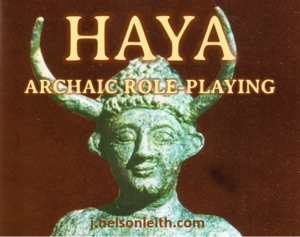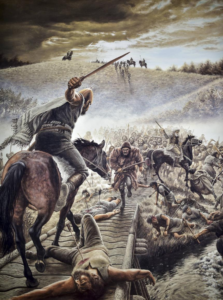 Classes
Classes
Setting-specific names for classes below are aligned with the classes of Dungeons & Dragons 5e. The weapons and armor available are limited to the Bronze and Stone Ages, of course.
The Bronze Age peoples are limited to all of the basic melee weapons (club, great club, dagger, hand axe, javelin, light hammer, mace, quarterstaff, sickle, and spear), some simple ranged weapons (dart, shortbow, sling, spear-thrower), some martial melee weapons (battle axe, short sword, trident, whip), and some martial ranged weapons (blowgun, long bow, net). They can wear leather, padded leather, studded leather, hide, scale mail, or splint mail armor, and wield hide, leather, wooden, or bronze shields.
The Stone Age peoples are limited to some of the basic melee weapons (club, great club, dagger, hand axe, javelin, light hammer, quarterstaff, and spear), some simple ranged weapons (dart, shortbow, sling, spear-thrower), one martial melee weapons (whip), and some martial ranged weapons (blowgun, long bow, net). They can wear leather or hide armor, and wield hide, leather, or wooden shields.
 Warrior (fighter) – The Warrior class is confined to the civilized/literate humans, the Yuta, Adya, Agtile, and Damdilit. They fight either as soldiers in state armies or as individual heroes renowned for their skill. Their technology can be either Stone and Bronze Age, depending on origin.
Warrior (fighter) – The Warrior class is confined to the civilized/literate humans, the Yuta, Adya, Agtile, and Damdilit. They fight either as soldiers in state armies or as individual heroes renowned for their skill. Their technology can be either Stone and Bronze Age, depending on origin.
Tracker (ranger) – The warrior equivalent of Stone Age races like the Zitan, Entihoma, Asnam, Otovyi, and Janis are all Trackers, owing to the hunger-gatherer lifestyles of those peoples. The literate peoples, both Bronze and Stone Age, also can be Trackers, who usually act as traders between the farming and hunter-gatherer peoples.
Hunter (barbarian) – This class is restricted to the demihumans: Himhet, Sebilos, Otovyi, and Janis. They represent champions among the Tackers of their clans. Hunters are confined to Stone Age melee weapons.
Rogue – The Rogue is only available to the civilized, urban peoples of Yuta, Adya, Agtile, and Damdilit, as they rely on urban economies. Many of them operate at sea as pirates, robbing Traders who move between urban centers.
Poet (bard) – Poets who use chronicle stones are restricted to the literate Bronze Age Yuta, Adya, Agtile, and Damdilit peoples. The Izakhez are semi-literate, relying on petroglyphs carved in the landscape to learn new spells. The Inet, Yasayoi, and Far Islands peoples have Poets who have to learn spells by networking with other Poets. Literate Poets access their spell songs through anthology chronicle stones, and levels 5+ can copy these songs into their personal chronicle stones. Illiterate Poets have to rely on memory as bards in d20.
Trader (homebrew) – Traders are restricted to humans. They have very broad knowledge of the lands and peoples with which they trade, including the sea routes and paths overland, making them much like Trackers (rangers). Due to their perilous occupation, they also have martial skills similar to a Rogue. Traders also enjoy protection from laws and customs designed to maintain trade. This provides Traders social advantages similar to Poets (bards). There is more information on Traders below, since they are a homebrew class in the Haya setting.
Traders gain the following class features.
Hit Dice: 1d6 per rogue level
Hit Points at 1st Level: 6 + Constitution modifier
Hit Points at Higher Levels: 1d6 (or 4) + Constitution modifier per Tracker level after 1st
Proficiencies
Armor: Light armor (leather, padded, studded leather)
Weapons: Basic melee weapons, simple ranged weapons
Saving Throws: Intelligence, Wisdom, Charisma
Skills: Choose four from History, Investigation, Nature, Religion, Animal Handling, Insight, Medicine, Perception, Survival, Deception, Intimidation, Performance, and Persuasion.
Equipment: Trackers start with the following equipment, in addition to the equipment granted by their background:
(a) a club or (c) hand axe
(a) a shortbow and quiver of 20 arrows, (b) spear, or (c) set of three javelins
(a) a dungeoneer’s pack, or (b) an explorer’s pack
Leather armor, two daggers, and ledger stone
Level (Prof. Bonus) Features
1 (+2) Expertise, Bardic Inspiration (d6), Natural Explorer
2 (+2) Cunning Action, Jack of all Trades
3 (+2) Fighting Style, Trader archetype
4 (+2) Ability Score Improvement
5 (+3) Bardic Inspiration (d8), Font of Inspiration
6 (+3) Countercharm, Expertise
7 (+3) Natural Explorer improvements, Trader Archetype feature
8 (+3) Ability Score Improvement
9 (+4) Land’s Stride
10 (+4) Ability Score Improvement
Trader Archetypes
Frontiersman. These Traders focus on remote areas and uncivilized peoples. They lean toward Trackers (rangers) in their archetypal techniques.
Linguistic talent. At 3rd level, the Trader can learn an extra language above normal. Of course, this must be the language of a people the Frontiersman trades with.
Frontier knowledge. At 6th level, the Trader enjoys a +2 bonus to skill rolls in Nature, Animal Handling, Medicine, and Survival.
Steel Will. Much like the Ranger’s Hunter archetype Defensive Tactics proficiency of the same name, this gives the Frontiersman a bonus at 9th level on saving throws against being frightened, a +2 bonus.
Merchant. These Traders focus on trading in cities, towns, and marketplaces. They lean toward Poets (bards) in their archetypal techniques.
Linguistic talent. At 3rd level, the Trader can learn an extra language above normal. Of course, this must be the language of a people the Merchant trades with.
Cutting Words. This is much like the Bardic College of Lore proficiency of the same name. The following language is borrowed from that proficiency. At 6th level, the Merchant knows how to use wit to distract, confuse, and otherwise sap the confidence and competence of others. When a creature that you can see within 60 feet of you makes an Attack roll, an ability check, or a damage roll, the Merchant can use his/her reaction to expend one use of Bardic Inspiration, rolling a Bardic Inspiration die and subtracting the number rolled from the creature’s roll. The Merchant can choose to use this feature after the creature makes its roll, but before the referee determines whether the Attack roll or ability check succeeds or fails, or before the creature deals its damage. The creature is immune if it can’t hear you or if it’s immune to being Charmed.
Urban knowledge. At 9th level, the Trader enjoys a +2 bonus to skill rolls in History, Deception, Intimidation, Performance, and Persuasion.
Shipper. These Traders focus on seafaring. They lean toward Rogues in their archetypal techniques.
Fancy Footwork. Much like the Rogue’s Swashbuckler archetype proficiency of the same name, this allows the Shipper at 3rd level to land a strike and then slip away without reprisal. During his/her turn, if the Shipper make a melee attack against a creature, that creature can’t make opportunity attacks against the Trader for the rest of the turn.
Maritime knowledge. At 6th level, the Trader becomes adept at the reading the tides, currents, and winds, as well as the habits of sea creatures. This gives +2 bonuses to any skill or feat rolls related to understanding the maritime realm.
Multi-attack Defense. Much like the Ranger’s Hunter archetype Defensive Tactics proficiency of the same name, when an opponent attacks the character at 9th level or higher with the Shipper archetype, he/she gets a +4 bonus to AC against all subsequent attacks made by that creature for the rest of the turn.
Scribe (wizard) – Scribes are restricted to the literate Bronze Age Yuta, Adya, Agtile, and Damdilit races. They access their spells through a personal chronicle stone, into which they copy spells from other chronicle stones. Scribes also have unique access to ancient knowledge through the chronicle stones and are sought out not only for their spell-casting abilities but also the histories they archive.
There are Societies of Scribes dedicated to maintaining individual chronicles, those chronicle stones that can be updated. These include timelines of events, genealogies of prominent families, records of Priesthood membership, and journey stones (like the Greek periplus and Roman itinerarium) that record distances between locations, and details about those locations, along roads and coasts.
Shaman (sorceror) – The shaman of Stone Age tribes are those who were opened to the world of magic via some traumatic experience, an attack by a totem animal or a spiritual seizure or learning of a shamanic pedigree. After that, they become the holy men or holy women of their clans, channeling magical energy from the Spirit Folk and the gods.
Priest (cleric) – The holy men of civilized peoples, they communicate with the gods and advise the aristocrats.
Elder (druid) – This class is restricted to the Asnam people, for whom they are the primary spell-casters.
